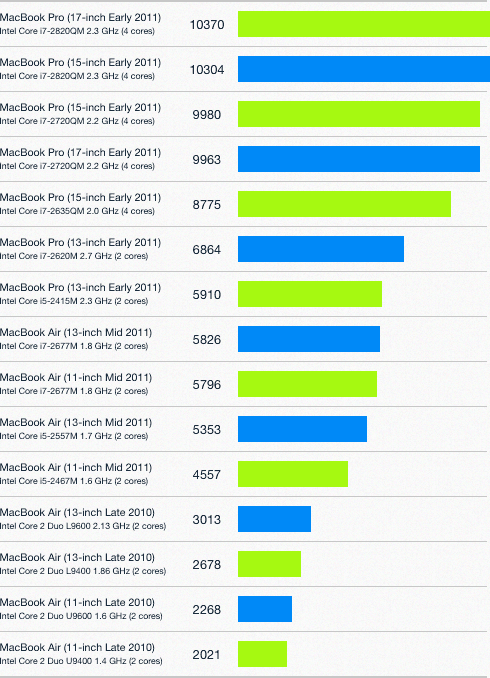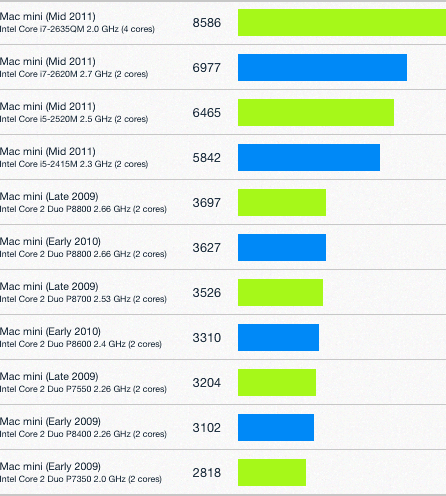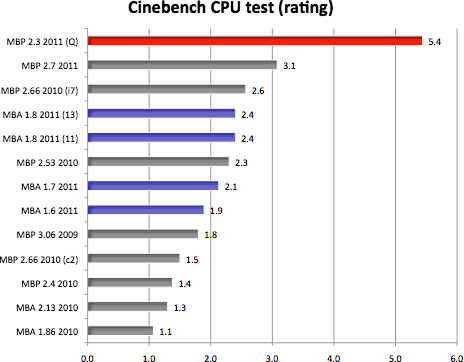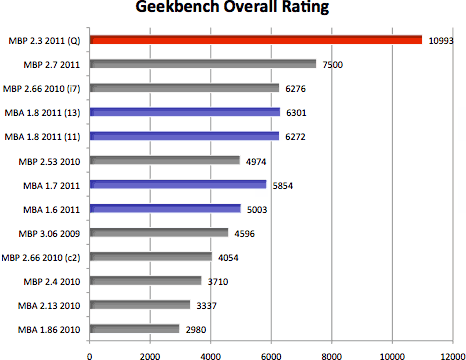General Apple and Mac desktop news is covered in Mac News Review. iPad, iPod, iPhone, and
Apple TV news is covered in iOS News
Review. All prices are in US dollars unless otherwise noted.
News & Opinion
Reviews
Tech Trends
Products & Services
News & Opinion
Are Intel Integrated Graphics Finally Good
Enough?
Ars Technica's Chris Foresman reports that despite lugubrious
predictions of a significant diminishment in graphics performance with
the switch to Intel HD Graphics 3000 GPUs (displacing the Nvidia
GeForce 320M GPUs in the preceding models), investigation reveals that
performance with the with the Sandy Bridge CPU equipped 13" MacBook Pro
introduced earlier this year and last week's refresh of the MacBook Air
remains largely constant, with the onboard Intel graphics comparable to
low-end discrete GPUs, while in many cases reducing overall power
consumption.
Publisher's note: Although Intel integrated graphics have long been
maligned for lackluster performance, I can't say that I've had any
objection to the Intel GMA 950 graphics built into my 2007 Mac mini. I'm not a gamer, and
I don't notice any graphics slowdown compared to the AGP 4x Radeon 9000 graphics cards in
my dual 1 GHz and dual 1.6 GHz G4 Power Macs - and that's running
a 20" ADC Apple Cinema Display at its native 1680 x 1050 resolution
with millions of colors (one of the Power Macs is running a 22" Apple
Cinema Display at its native 1600 x 1024 resolution, so setups are
comparable). dk
Link: Are Intel
Integrated Graphics Finally Good Enough for the MacBook Air?
Primate Labs Posts July Mac Benchmarks

Geekbench scores for 2010-2011 MacBook Airs.

Geekbench scores for 2009-2011 Mac minis.
Primate Labs says:
"There are enough results in the Geekbench Result Browser for last
week's new Mac models that I can now update the Mac Benchmark charts.
To highlight the performance of the new Mac mini and the new MacBook
Air I've provided charts . . . that compare the new Macs
against other Macs. This allows you to easily see the performance
improvements with the new Macs....
"The Sandy Bridge processors in the new Mac mini provide a
tremendous boost in performance: the quad-core Mac mini server is 2.3x
faster than the previous Mac mini while the dual-core Mac minis are
1.6x to 1.9x faster.
"Another interesting thing (not shown in the chart above) is that
the Mac mini Server has roughly the same performance as the entry-level
Mac Pro...."
Link: Primate
Labs Posts July Mac Benchmarks
MacBook Air Uses Half-power Thunderbolt
SlashGear's Chris Davies notes that the new MacBook Air may have a
Thunderbolt port, but size and cost constraints have led to the updated
ultraportable offering reduced external display support in comparison
to its MacBook Pro, iMac, and Mac mini siblings, citing an
AnandTech report that the Air uses an Eagle Ridge Thunderbolt chip,
which only supports half the data channels (two 10 Mbps channels
instead of four, which should suffice) of the chip found in the other
recent Apple models, as well as a single DisplayPort output.
Link: MacBook Air Gets
Half-power Thunderbolt
Wicked Fast 1 TB WD Scorpio Blue Notebook
Drive
Hot Hardware's Dave Altavilla says that notebook hard drives have
generally followed a similar track as other mobile components, tending
to be much smaller, lighter, and consume less power, but also offer
lower performance, features, and capacity versus their desktop
counterparts.
It's not so long ago that terabyte-sized desktop hard drives were
groundbreaking, and Altavilla says notebook hard drive capacities
reaching a full terabyte currently have to be considered bleeding-edge,
and while a 1 TB notebook drive might be regarded as primarily
targeting the mobile workstation market, he's willing to bet there are
more than a few pack rats among mainstream laptop users who will be
interested in Western Digital's new 1 TB 9.5mm Scorpio Blue 2.5"
notebook drive - the first drive to squeeze that capacity into an
industry standard 9.5mm, 2.5" SATA form-factor, achieving a density per
platter of 500 GB.
Publisher's note: Of particular interest is the fact that this 5400
rpm 6 Gbps SATA drive (not to be confused with the previous 5200 rpm
12.5mm 3 Gbps SATA version), which should draw less power and run
cooler than a 7200 rpm drive, actually benchmarks faster than the 7200
rpm WD Scorpio Black, previously among the fastest notebook drives.
Pricing is comparable to the 750 GB Scorpio Black, so you 33% get more
capacity per dollar and a faster drive with the 5400 rpm 1 TB Scorpio
Blue. This could be the ultimate Mac mini and MacBook hard drive
upgrade. dk
Link: A Terabyte for
Notebooks: WD Scorpio Blue 1 TB Drive
Purchase links: $127
from Amazon.com, $130.99
from OWC
Recovering from Hard Drive Failure More Difficult
with Lion
MacTrast's J. Glenn Künzler says that after ordering a 15" 2011
MacBook Pro on OS X Lion's launch day, suspecting that there might be
some interesting differences, he was disappointed when he finally
received the new machine a week later, discovering that the main
difference is that that purchasers of a post-Lion MacBook Pro no longer
have a quick and Apple-sanctioned way to recover from hard drive
failure without Apple's intervention.
Link: Recovering from
HDD Failure More Difficult with Macs Shipped Post-Lion
Which Macs Are AirDrop Compatible?
Hardmac's Lionel notes that that AirDrop, one of the new features of
OS X 10.7 Lion, doesn't work on all Macs compatible with the new OS.
Only Macs with WiFi cards that can handle both an ad hoc and an
infrastructure connection are compatible.
Apple has published a list of compatible Macs:
- MacBook Pro (Late 2008 or newer)
- MacBook Air (Late 2010 or newer)
- MacBook (Late 2008 or newer)
- iMac (Early 2009 or newer)
- Mac mini (Mid 2010 or newer)
- Mac Pro (Early 2009 with AirPort Extreme card, or Mid 2010)
Other models are not compatible, although Lionel says it's
theoretically possible to make older Macs that support a mini
PCI-Express 1x interface compatible by replacing their AirPort Card
with a compatible one, such as the Broadcom BCM94322MC chipset that can
be installed in a non-compatible Mac Pro, MacBook (and Pro), iMac, and
Mac mini.
Link: AirDrop
Compatible? Which Macs Make the Cut?
15" MacBook Air Coming This Year?
Hardmac's Lionel comments on rumors that Apple is testing prototypes
of a new laptop halfway between the 15" MacBook Pro (for display size)
and the MacBook Air (for thinness) that could be available for the
holiday season.
Whether it will be a MacBook Pro or another MacBook Air remains a
conundrum, but Lionel muses that removing the SuperDrive and the 2.5"
hard drive, which would be replaced by an SSD, as in the MacBook Air,
would save a lot of space, but he's skeptical that Apple will be able
to keep a CPU consuming 45 W to 55 W at full load in a thin laptop, and
would probably have revert to smaller and slower CPUs, probably
dual-core models like in the current MacBook Air models.
For that reason, he's of a mind that that these new laptops, if they
are ever marketed, will be sold alongside - rather than in place of -
the MacBook Pro, at least until heat and power consumption are
addressed, hopefully by Intel's coming TriGate technology coupled to
the 22 nm manufacturing process.
Lionel adds that while he's serene about losing the SuperDrive, but
the disappearance of a 2.5" slot for a hard drive or SSD would be
another matter, especially in a Pro laptop, to say nothing of
non-upgradable memory should Apple decide to solder the new laptop's
RAM to the motherboard like it does with the MacBook Air.
Link: A 15" MacBook Air
for the Holiday Season?
Reviews
4 New MacBook Air Configurations vs. 9 Other
MacBooks
Bare Feats' Rob-Art Morgan says:
"In response to popular demand, this is an attempt to put the 2011
MacBook Air in perspective by comparing it to previous MacBook Airs. We
included various examples of MacBook Pro as far back as 2009. For this
performance snapshot, we chose Cinebench and Geekbench because they
emphasize CPU power, because we've collected test results for both over
the past two years, and because you can easily obtain both benchmarking
apps to see how your Mac compares....


"With the exception of the 2011 Quad-Core i7 MacBook Pro, the 2011
MacBook Air does well versus MacBook Pros. And it is a significant
performance improvement over previous MacBook Airs."
Link: Performance Snapshot: Four
2011 MacBook Airs Versus Nine Other Apple Laptops
AnandTech: 2011 MacBook Air Thoroughly
Reviewed
I've avidly perused dozens of Mid 2011 MacBook Air reviews over the
past 10 days or so, some of them quite in-depth, but nothing
approaching the thoroughgoing analysis of these new machines posted by
AnandTech's Anand Lal Shimpi.
Shimpi observes that while last year's MacBook Air updates were
great alternatives to cheap, underpowered netbooks, they weren't fast
enough to be mainstream computers in 2011, still being powered by Intel
Core 2 Duo processors and based on architecture that debuted in 2006.
However, Apple has fixed the problem with Intel's 32nm Sandy Bridge
family of CPUs.
Like many other commentators, Shimpi notes that the principal
shortcomings of the base $999 11" Air configuration is that it only
comes with 2 GB of system memory and a 64 GB SSD. He deems the
latter excusable if you just don't do much with your system (and
technically, it's something you can upgrade down the line if you'd
like) but considers the hard-soldered RAM a major problem, severely
limiting flexibility, and he'd strongly recommend at least upgrading
the memory to 4 GB.
He also observes that while the 11" Air is almost tablet-like, the
13" model still looks and feels like a normal notebook - albeit a
really thin, really light notebook that is really a pleasure to use.
(And Apple really needs to increase the resolution of its 13" MacBook Pro which
has a paltry 1280 x 800 vs. the Air's 1440 x 900 pixel display). He
recommends that if you don't need more than 128 GB of internal storage,
the way to go is the base 13" model with a 128 GB SSD and 4 GB of RAM
at $1,299.
Shimpi concludes that while last year's models may have been great
ultraportables, this year's Airs are great notebooks, and if you like
thin and light ultraportables, the MacBook Air continues to be one of
the best options around.
Link: The 2011 MacBook
Air (11 & 13-inch): Thoroughly Reviewed
Core 'i' MacBook Air Treading on MacBook Pro
Turf
InfoWorld's Paul Venezia says that despite its many compromises and
limitations, he was an early-adopter of the original MacBook Air as his
primary laptop, and when the next iteration appeared with a
significantly lower price, a solid-state drive, and a faster CPU, he
jumped at the upgrade.
However, he concedes that while the Air steadily improved, it had
more in common with the MacBook than the MacBook Pro - a good
fit for users with general computing workloads, but not those requiring
support for heavy-duty, CPU-intensive apps. However, with Apple
offering an Air powered by a hyper-threaded, dual-core Intel Core i7
CPU, that's no longer the case, with the Air vaulting into the category
of a mobile workstation rather than an ultrathin terminal, Venezia says
he expects to see MacBook Airs in places he never would have before,
like the recording studios and video production houses that have been
the domain of Mac Pros and MacBook Pros.
But there's a catch: Some of the programs those users need are
incompatible with OS X 10.7 Lion.
Link: MacBook Air Takes
on MacBook Pro
Macworld: Core i5 MacBook Airs Approach
Perfection
Macworld's Jason Snell notes that with the new models Apple released
last month, the MacBook Air has arrived as an anchor product in the Mac
lineup - the laptop OS X Lion was designed for. Snell derives the
distinct impression that it's only a matter of time before all Mac
laptops look like the Air.
Snell reports that the price leader $999 11" Air, powered by a 1.6
GHz Core i5 processor, tests at 1.7 times as fast than the previous
$999 model on the same set of processor and storage-focused tests, and
on the HandBrake encode test it was 2.4 times as fast, although the
switch from the Nvidia GeForce 320M chipset in the preceding models to
Intel HD Graphics 3000 IGPUs in the latest models is a mixed story
performance-wise, with performance of the 2011 MacBook Air's graphics
subsystem "all over the map."
On the other hand, Snell observes that the Airs now being equipped
with a Thunderbolt I/O port changes everything - the new connection
technology vastly superior not just to USB, but to FireWire and eSATA
as well. Fast hard-drive transfers, gigabit ethernet, FireWire
compatibility - all of these features are now just a Thunderbolt
adapter or three away from being available to MacBook Air users. He
notes that with Apple's just-announced 27" Thunderbolt Display you get
a FaceTime HD camera, three USB 2.0 ports, a FireWire 800 port, a
gigabit ethernet port, and a Thunderbolt port on the back. Plug its
Thunderbolt cable into one of the new MacBook Air models, and you
essentially convert the laptop into a Core i5-powered desktop computer
complete with fast network connection, fast storage, and an array of
expansion ports - the old PowerBook
Duo concept updated for the 21st Century, and done better than the
old Duos.
Snell thinks the pick of the litter is the base 11" Air, and while
it might not be the perfect computer, but it's as close to perfect as
Apple's ever come in his estimation.
I think that calling a computer with a 64 GB (about 48 GB usable)
storage drive and just 2 GB of hard-soldered, non-upgradable RAM
"perfect" is just a wee bit extravagant. The new Airs are indubitably
among the beat laptops Apple has ever made, but perfection still eludes
them by a substantial margin.
Link: Core i5 MacBook
Airs Approach Perfection
Tech Trends
Intel's Strategy for the Ultrabook Market
Hardmac's Lionel comments on Intel's plan to develop the MacBook
Air-flattering Ultrabook market, noting that so far the MacBook Air is
the only proven commercial success in that market subsector. He reports
that Intel has decided to develop a plan of action in 3 steps.
Step 1 was in June with the launch of the new low power consumption
Core i5 and i7, which are already being used in the new MacBook
Air.
Step 2 will be mid-2012 with the Ivy-Bridge processors featuring the
new TriGate 22 nm manufacturing process, for a even lower electrical
consumption and more extensions with the better implementation of
Thunderbolt and (finally!) USB 3.0.
Step 3 will occur in 2013 with a new generation of processors with a
different architecture, but still in 22 nm, for now code named Haswell
- new architecture that Lionel says should be another landmark
improvement in electricity consumption.
Publisher's note: Or potential Ultrabook users could just buy the
new MacBook Air now. If previous MacBooks are any indication, it will
be
a better Windows notebook than anyone in the PC industry makes.
dk
Link: Intel's Plan of
Action for the Ultrabook Market
Ultrabook May Fail If Not Cheaper than MacBook
Air
DigiTimes' Monica Chen and Joseph Tsai report that while Intel is
positioning its "ultrabook" as a set of specifications to enable
Windows PC partners to design notebooks imitating Apple's MacBook Air,
ultrabooks may encounter the same frustrations as the previous round of
CULV notebooks did if prices are not lower than those of the Air,
according to sources from Taiwan-based supply chain makers.
Chen and Tsai's sources point out that Intel's ultrabook concept
brings no new new innovation, but simply a design to allow first-tier
notebook players to quickly catch up with Apple's advances in the
ultra-thin segment and help the notebook industry recover from the
impact of tablet PCs.
For example, Ultrabooks will essentially copy MacBook Air design and
engineering points such as li-polymer batteries, metal chassis for
better heat dissipation, and a solid state drive (SSD) storage, and
(regrettably - ed.) all internal components soldered on to the
machine's logic board to save space and reduce weight.
The sources contend that designing an ultrabook based on Intel's
technical suggestions at a price lower than the MacBook Air's won't be
possible unless Intel is willing to reduce its prices, which already
account for one-third of the total cost.
Link: Ultrabook May
Suffer Defeat If Not Cheaper than MacBook Air, Say Taiwan Makers
(subscription required)
Products & Services
$39 Alternative to Apple's External
SuperDrive
Hardmac's Lionel notes that while Apple's SuperDrive for the MacBook
Air and Mac mini is very elegant, it's also very expensive at $79, and
also heavy due to its solid aluminum construction.
However, he reports that Samsung has just announced a new line of
external DVD drives that can read and write CD 24x, DVD 8x, DVD-RAM 5x,
DVD-R DL and DVD +-RW 6x, and will be available in August for $39, half
the price of the Apple SuperDrive, and with the added advantage that it
will work on any PC or Mac, while the Apple external SuperDrive will
work only on a MacBook Air or Mac mini running Snow Leopard or
Lion.
Link: A New Alternative
to Apple's External SuperDrive
Bargain 'Books
For deals on current and discontinued 'Books, see our 13" MacBook and MacBook Pro,
MacBook Air, 13" MacBook Pro, 15" MacBook Pro, 17" MacBook Pro, 12" PowerBook G4, 15" PowerBook G4, 17" PowerBook G4, titanium PowerBook G4,
iBook G4, PowerBook G3, and iBook G3 deals.
We also track iPad,
iPhone, iPod touch, iPod classic, iPod nano, and iPod shuffle deals.






